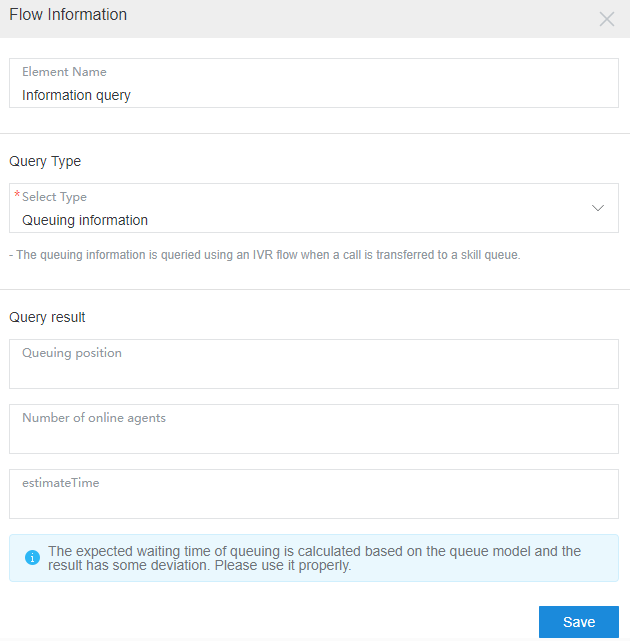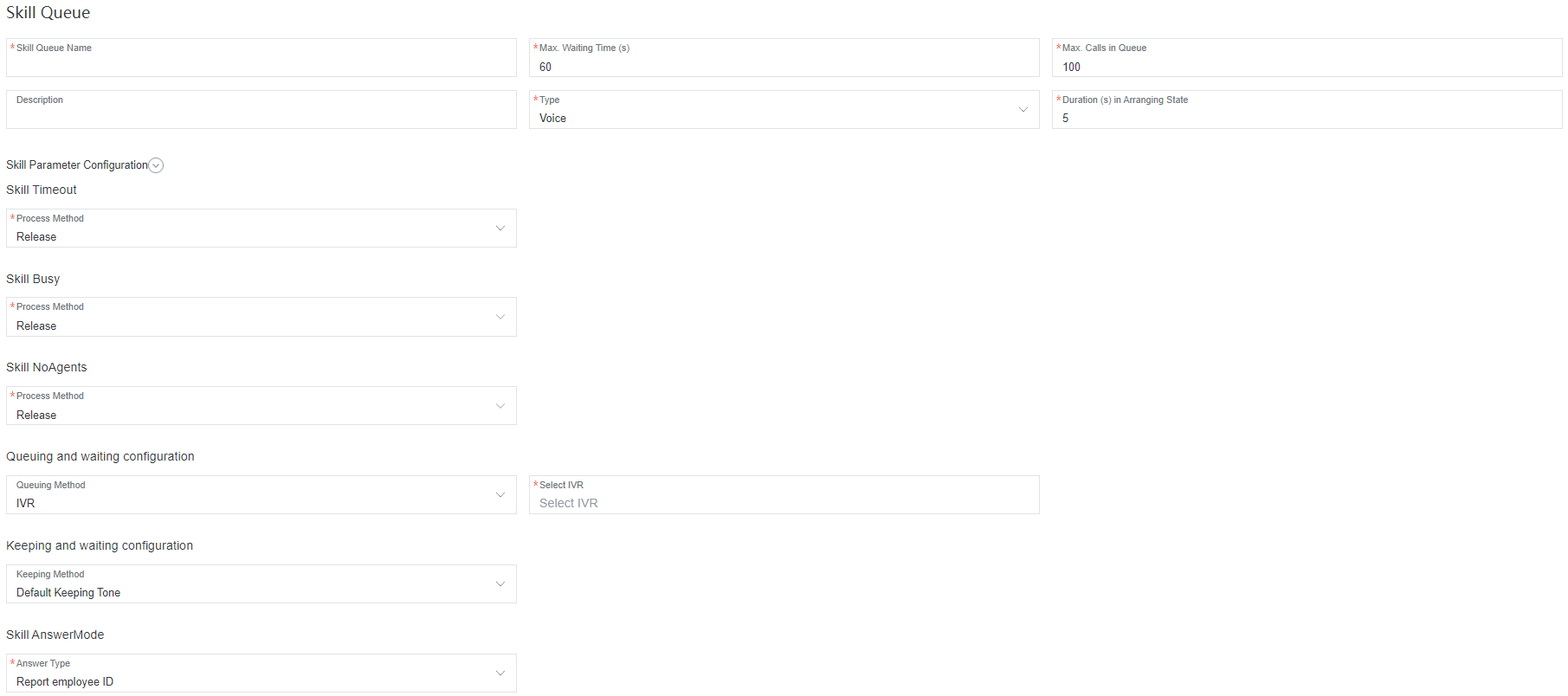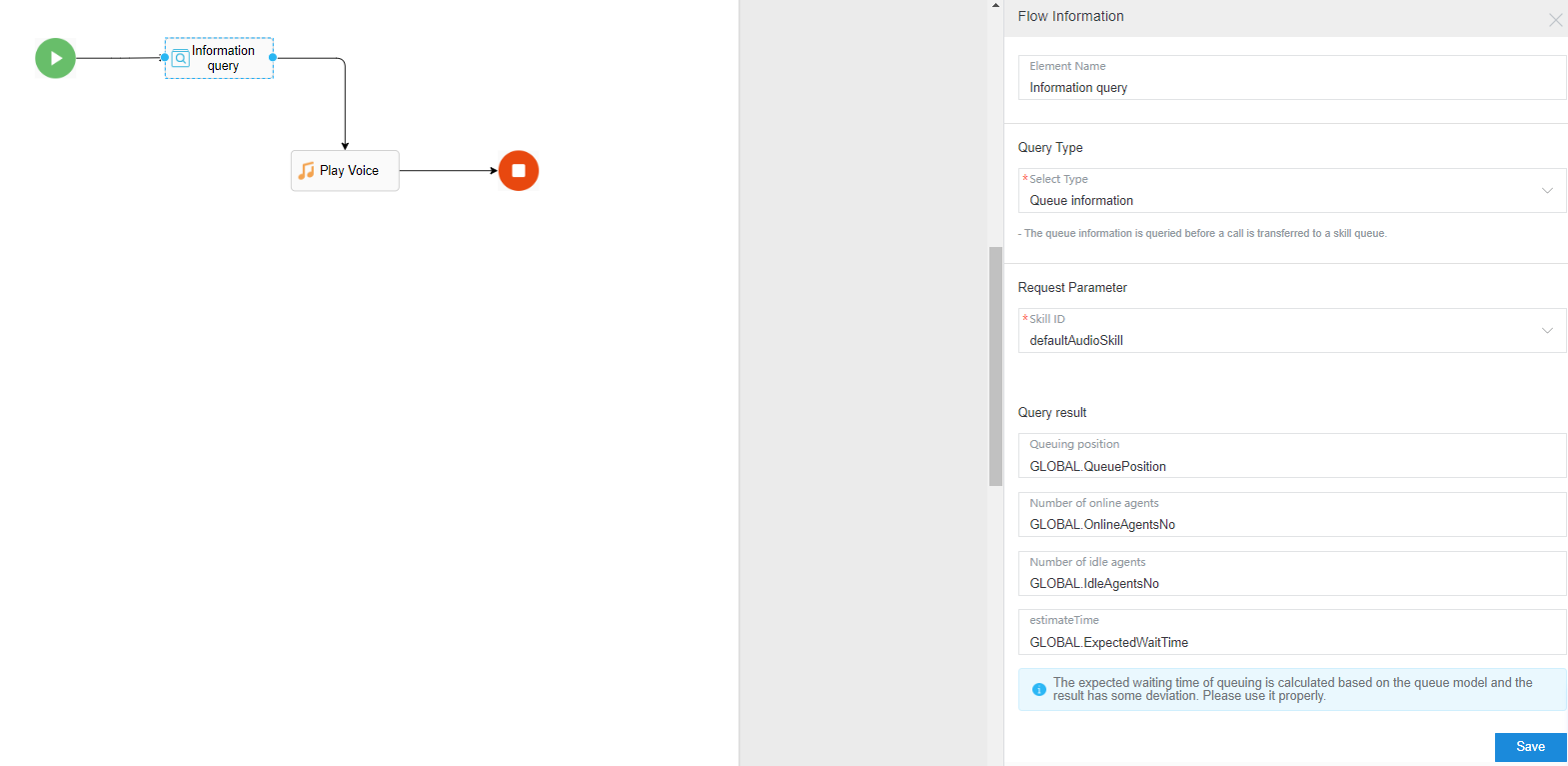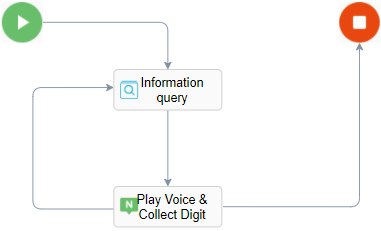Information Query
Currently, you can query the queuing position, the number of all online agents in a skill queue, and the estimated time required for accessing an agent.
You can query details about agents in configured skill queues.
You can query whether the user is in the special list.
Diagram Element

Parameter Description
The following figure shows the parameters of the Information query diagram element.

The parameters are described as follows:
- Querying queuing information
- Query Type: information type that can be queried using this diagram element. Currently, queuing information can be queried.
The queuing information is queried using the call waiting tone played with an IVR when a call is transferred to a skill queue.
- Query result
- Queuing position: position of a user in the current skill queue, that is, the number of queuing users in front of the user. Use a global variable (GLOBAL.*) or flow variable (FLOW.*) to save the value for subsequent operations.
- Number of online agents: total number of online agents in the skill queue to which a user belongs. Use a global variable (GLOBAL.*) or flow variable (FLOW.*) to save the value for subsequent operations.
- estimateTime: estimated duration for connecting a call to an agent during queuing. This parameter is affected by the queuing position and the number of online agents. Use a global variable (GLOBAL.*) or flow variable (FLOW.*) to save the value for subsequent operations. The estimated waiting time depends on the queue model. The result may be inaccurate. Therefore, use this parameter properly.
- Query Type: information type that can be queried using this diagram element. Currently, queuing information can be queried.
- Querying queue information
- Query Type
Queue information: Query queue information before a call is transferred to a skill queue.
- Request Parameter
Skill ID: skill queue to which a call is transferred.
- Query result
- Queuing position: Before a call is transferred to a skill queue, the estimated queuing position of the customer is displayed. Use a global variable (GLOBAL.*) or flow variable (FLOW.*) to save the value for subsequent operations.
- Number of online agents: total number of online agents in the skill queue to which a call is transferred. Use a global variable (GLOBAL.*) or flow variable (FLOW.*) to save the value for subsequent operations.
- Number of idle agents: total number of online and idle agents in the skill queue to which a call is transferred. Use a global variable (GLOBAL.*) or flow variable (FLOW.*) to save the value for subsequent operations.
- estimateTime: estimated time for connecting a call to an agent after the call is transferred to a skill queue. Use a global variable (GLOBAL.*) or flow variable (FLOW.*) to save the value for subsequent operations. The estimated waiting time depends on the queue model. The result may be inaccurate. Therefore, use this parameter properly.
- Query Type
- Querying the queue name
- Query Type
Queue name: The name of a skill queue to which an agent belongs can be queried based on the agent ID.
The scenario is to query the skill queue name based on the agent ID before the call is transferred to the skill queue.
- Request Parameter
Agent ID: agent ID. Flow variables or constants are supported.
- Query result
Queue Name: name of the voice skill queue with the highest weight in the skill queue to which the agent ID belongs. Use a global variable (GLOBAL.*) or flow variable (FLOW.*) to save the value for subsequent operations.

You can choose to configure the skill queue weight.
- Query Type
- Querying special list information
- Query Type
Special list information: Currently, the system can check whether a user is in the special list based on the user number. The next processing flow varies depending on the special list query result.

The special list refers to the blocklist.
- Query result
Flag of Being in the Special List: whether the calling number exists in the special list. Use a global variable (GLOBAL.*) or flow variable (FLOW.*) to save the value for subsequent operations.
The values of Flag of Being in the Special List are as follows: 0 indicates that the calling number does not exist in the special list, and 1 indicates that the calling number exists in the special list.
- Query Type
Typical Application Scenarios
A user makes a call to the CEC and the call is routed to a skill queue. When all agents in the skill queue are busy, the IVR can use this diagram element to obtain the current queuing status of the user and play the call waiting tone to the user if the call waiting tone played with an IVR is configured. Therefore, the user can determine whether to continue waiting based on the queuing status.
To configure the call waiting tone played with an IVR, perform the following operations:
- Application scenario of queuing information
Choose , click Edit corresponding to the skill queue, and set Queuing Method in the Queuing and waiting configuration area.

You can select a flow that you edited for the call waiting tone played with an IVR. In the flow, the diagram element can be used to query data, including the number of online agents, queuing position, and estimated waiting time.
Flow development process:
- Create three global variables to receive the query result, and then configure the TTS voice playback. The voice playback content is replaced by the created global variables.

- Create a flow, use the information query diagram element to assign values to the three global variables defined above, and then use the voice playback diagram element to play the preceding TTS content.
- The subsequent operations are performed based on the services. The playback is repeated or other branches are used.
- Application scenario of queue information
- The parameter settings are the same as Application scenario of queuing information. The TTS voice playback diagram element is added.
- When using the diagram element to create a flow, if you want to transfer a call to a skill queue in the flow, you can query the information about the skill queue and then determine whether to transfer the call to the skill queue. The subsequent businesses are determined based on site requirements.
The flow is shown in the following figure. You need to select a skill queue to be queried.
Figure 1 Flow example Figure 2 Query result variables
Figure 2 Query result variables
- Application scenario of special list information
- During IVR flow management, a tenant administrator can query special list information in the Information query diagram element of a flow. The next processing flow varies according to Query result under Special list information.
- When the IVR flow runs to the special list information query node, the flow invokes the CC-Management to query the special list information, obtains the query result, and enters different processing flow nodes based on the query result.
Figure 3 Flow example

Feedback
Was this page helpful?
Provide feedbackThank you very much for your feedback. We will continue working to improve the documentation.See the reply and handling status in My Cloud VOC.
For any further questions, feel free to contact us through the chatbot.
Chatbot







